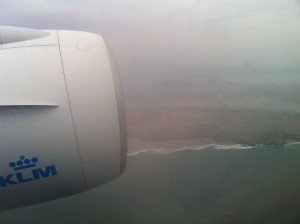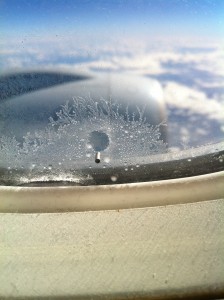Plane Truth - Why Do Aircraft Fly
 I don't know about you but I imagine all of us who fly from time to think about the unthinkable. I mean it is quite unbelievable these flying machines. I looked up the KLM webpage and here are the technical reasons as to why a plane stays up in the air. the following text has been pasted from a page on the KLM website.
A Boeing 747 filled with passengers, cargo, and fuel can weigh more than 400,000 kilos. How do you get an aircraft with that amount of weight into the air? And, how do you keep it there? Simple! An aircraft is help up by air.
Similar to water, air provides lift - it holds things up. Just looks at a wind storm. The wind pulls all kinds of things from the ground and blows them away. The harder the wind blows, the heavier the things are that it can pick up. Following that idea, aircraft create their own little "storm."
Engines Create a Storm
This storm is caused by the engines as the aircraft races down the runway, preparing for takeoff. The faster it goes, the more air comes under the wings. As a result of the shape of the wings (they're a little bit rounded on the top) the air has to travel a bit farther over the wings than under them. Behind the wings the air flows meet up again. This causes a "low pressure system" above the wing. The faster the air travels, the lower the pressure is. Finally, the pressure difference is so great that it pulls the jet up into the air.
To help very heavy aircraft to fly, you just have to do two simple things - make the wings bigger and the engines more powerful. Aircraft designers usually use both tricks together, as this has the greatest effect.
Takeoff
As the aircraft hurtles down the runway, finally attaining a speed of 300 kilometers per hour, the pilot pulls back on the "steering wheel" (the yoke). This serves to lift the nose wheels off the runway and, finally, the whole aircraft takes off. With the help of flaps on the wings and tail, the pilot can adjust how the air flows around the aircraft. By adjusting the flaps more on one side than the other, the pilot can steer the aircraft up and down, left and right. Using other flaps, the pilot can slow the aircraft down in the air, for instance, to prepare for landing.
Here's a wee poem I wrote on my last flight to Peru. What was really scary was the bullet hole that seemed to be lodged in the outside window. the more I looked at it the more I thought could this really be a bullet hole?
I don't know about you but I imagine all of us who fly from time to think about the unthinkable. I mean it is quite unbelievable these flying machines. I looked up the KLM webpage and here are the technical reasons as to why a plane stays up in the air. the following text has been pasted from a page on the KLM website.
A Boeing 747 filled with passengers, cargo, and fuel can weigh more than 400,000 kilos. How do you get an aircraft with that amount of weight into the air? And, how do you keep it there? Simple! An aircraft is help up by air.
Similar to water, air provides lift - it holds things up. Just looks at a wind storm. The wind pulls all kinds of things from the ground and blows them away. The harder the wind blows, the heavier the things are that it can pick up. Following that idea, aircraft create their own little "storm."
Engines Create a Storm
This storm is caused by the engines as the aircraft races down the runway, preparing for takeoff. The faster it goes, the more air comes under the wings. As a result of the shape of the wings (they're a little bit rounded on the top) the air has to travel a bit farther over the wings than under them. Behind the wings the air flows meet up again. This causes a "low pressure system" above the wing. The faster the air travels, the lower the pressure is. Finally, the pressure difference is so great that it pulls the jet up into the air.
To help very heavy aircraft to fly, you just have to do two simple things - make the wings bigger and the engines more powerful. Aircraft designers usually use both tricks together, as this has the greatest effect.
Takeoff
As the aircraft hurtles down the runway, finally attaining a speed of 300 kilometers per hour, the pilot pulls back on the "steering wheel" (the yoke). This serves to lift the nose wheels off the runway and, finally, the whole aircraft takes off. With the help of flaps on the wings and tail, the pilot can adjust how the air flows around the aircraft. By adjusting the flaps more on one side than the other, the pilot can steer the aircraft up and down, left and right. Using other flaps, the pilot can slow the aircraft down in the air, for instance, to prepare for landing.
Here's a wee poem I wrote on my last flight to Peru. What was really scary was the bullet hole that seemed to be lodged in the outside window. the more I looked at it the more I thought could this really be a bullet hole?
 Defying gravity
Defining insanity
Dicing with death
We move through space
A thousands dreams
Locked behind closed eyes
Scanning the possibilities
An ever active mind
Weighs up the odds
We're flying high
On a flight of faith
Sleeping through time
Moving on a wing
High in the sky
Self contained
Doors locked
Imprisoned for 12 hours
Eating and drinking
No one mentions
The Elephant in the plane
Defying gravity
Defining insanity
Dicing with death
We move through space
A thousands dreams
Locked behind closed eyes
Scanning the possibilities
An ever active mind
Weighs up the odds
We're flying high
On a flight of faith
Sleeping through time
Moving on a wing
High in the sky
Self contained
Doors locked
Imprisoned for 12 hours
Eating and drinking
No one mentions
The Elephant in the plane
